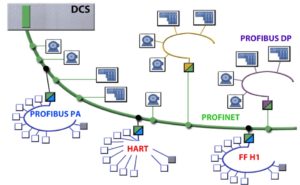PROFIBUS PA cables can land in hazardous environments; Ethernet cables cannot –yet. However, PROFINET is still a great backbone in process applications for today and tomorrow. Meaning, PROFINET can form the backbone of the control network, and intrinsically safe networks can be used where Ethernet cannot. Proxies allow for the integration of HART, PROFIBUS PA, and Foundation Fieldbus networks into the PROFINET backbone.
Other benefits of PROFINET here include direct connection to motor control centers, drives, and PLCs, greater bandwidth, larger address spaces, bigger messages, faster communication speeds, and more diagnostics. This is the current status of networking process control applications. In the future, work is being done to implement Ethernet in hazardous environments too.
Just as PROFIBUS DP and PROFIBUS PA use the same protocol on different physical layers, PROFINET is looking to a similar future. PROFIBUS DP uses RS485 whereas PROFIBUS PA uses MBP (Manchester-encoded Bus Powered). Similarly, the physical layer requirements allowing PROFINET to land in hazardous environments would be very similar to PROFIBUS PA’s physical layer requirements, namely:
- Limited current/voltage (intrinsically safe)
- Two-wire connection
- Power over the two-wire cable
- Wired segments longer than Ethernet’s 100-meter limit
- Same PROFINET protocol on new physical layer
So the same PROFINET protocol that currently runs over standard unmodified Ethernet would additionally run over an Ethernet variant suitable to process environments. These results may be a few years away. In the meantime, PROFINET is still the right backbone for process applications. That is why for non-hazardous environments, PROFINET is already available as an interface on many process instruments.
To see PROFINET in action in a process control demo, visit the PI booth on the SPS/IPC/Drives Show.

